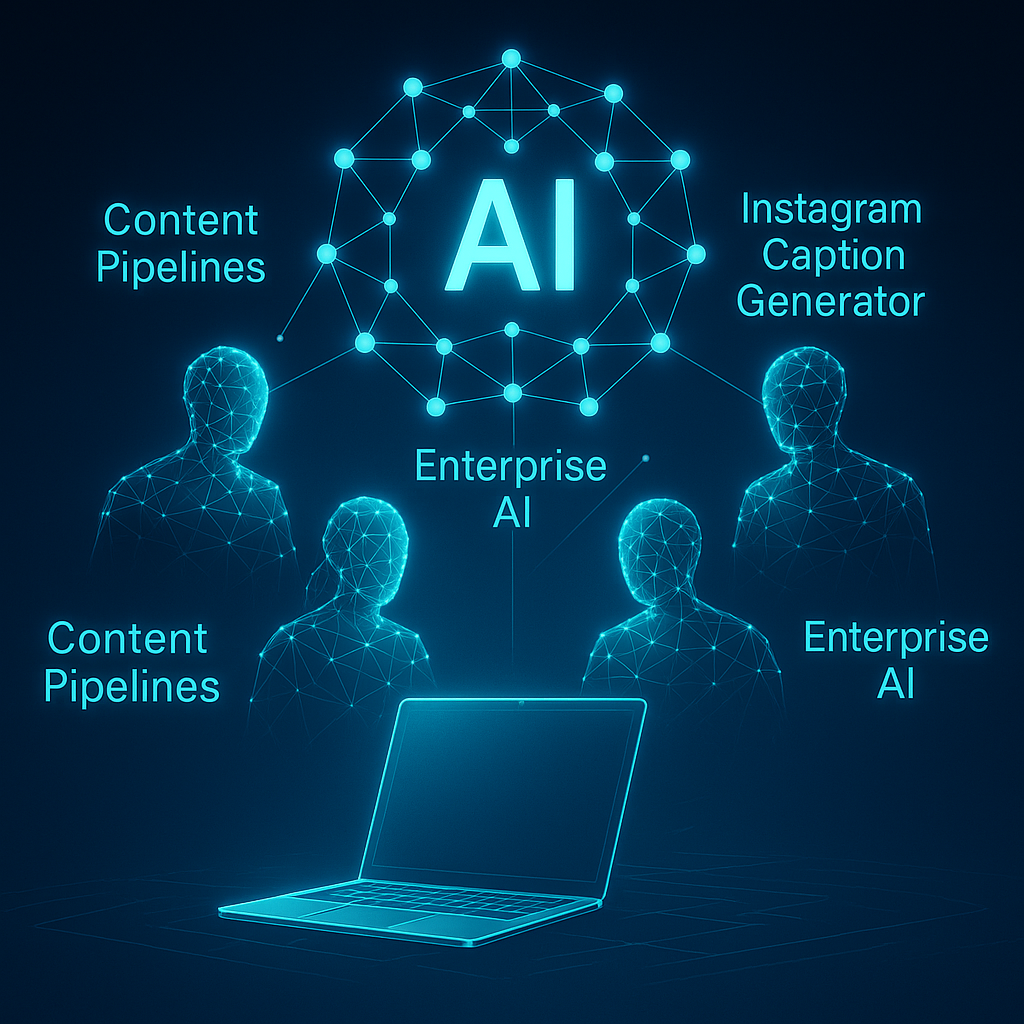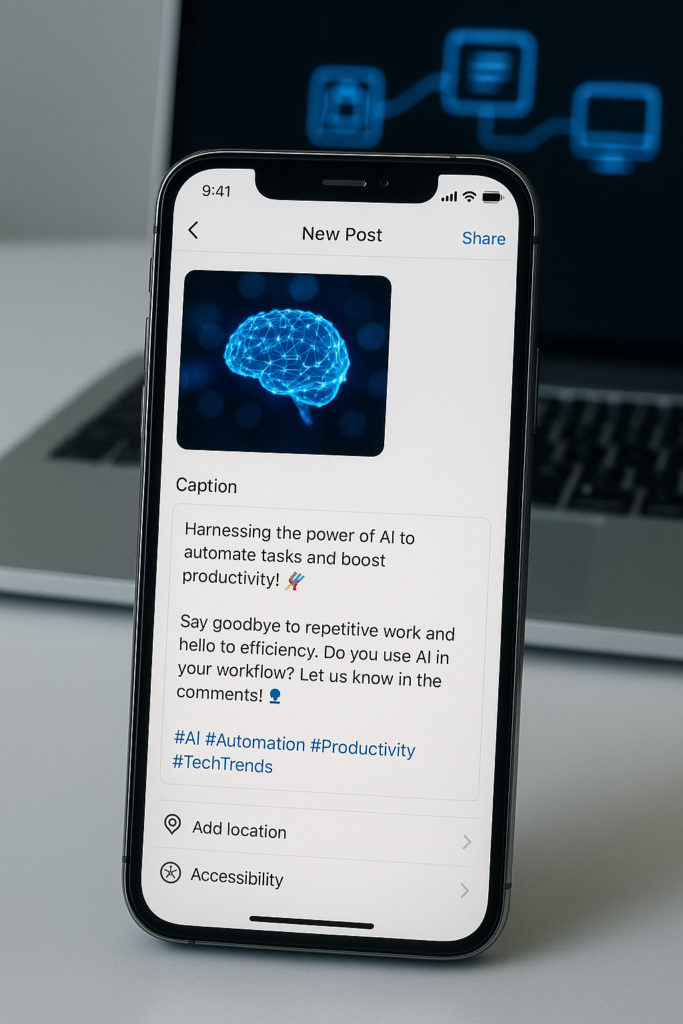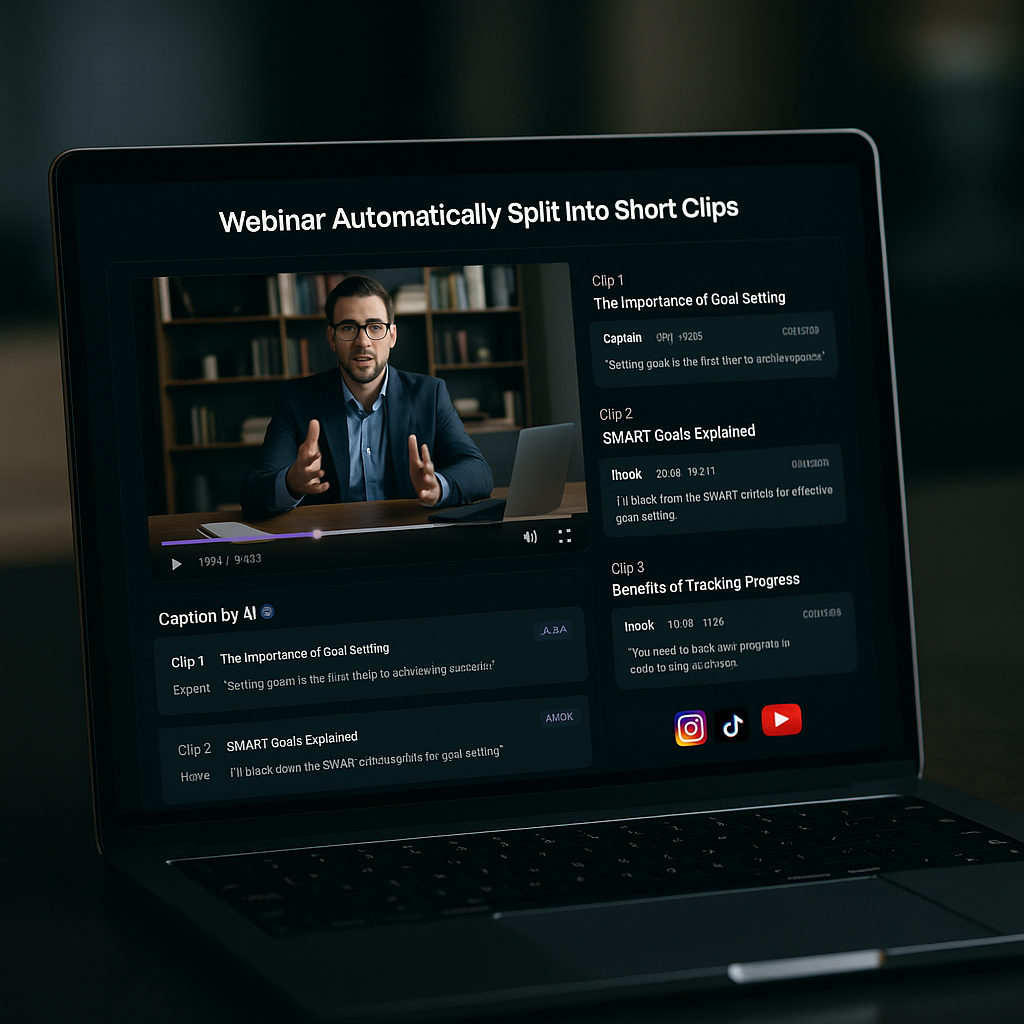Physical Address
304 North Cardinal St.
Dorchester Center, MA 02124
Physical Address
304 North Cardinal St.
Dorchester Center, MA 02124

Have you ever wondered how an Instagram Caption Generator can completely change the way you create content for social media? With the rise of AI content generation, businesses, creators, and even enterprises are discovering faster, smarter, and more creative ways to connect with their audiences. From witty captions to professional storytelling, these tools are making it easier than ever to stand out online.
But here’s the exciting part—we’re no longer limited to one-size-fits-all solutions. Thanks to multi-agent AI, we now have intelligent systems that work together like a team. One agent can brainstorm captions, another can refine tone, a third can analyze hashtags, while yet another ensures everything aligns with your brand voice. This kind of collaboration is unlocking new possibilities not only for social media creators but also for enterprises building large-scale digital strategies.
Of course, this innovation is raising big conversations. Some worry about the future of AI content writer jobs, while others are embracing AI content generation tools to scale productivity. In reality, AI isn’t here to replace human creativity—it’s here to enhance it. By combining human imagination with machine efficiency, creators and enterprises can achieve more in less time.
At the enterprise level, the adoption of enterprise artificial intelligence is revolutionizing marketing pipelines. From blogs and ecommerce descriptions to captions and podcasts, AI pipelines are becoming a core part of modern business strategies.
In this blog, we’ll explore 5 brilliant multi-agent AI content pipelines that are reshaping digital marketing. Plus, we’ll dive deeper into the Instagram Caption Generator—a must-have tool for anyone looking to level up their online presence.

If you’ve ever tried to do everything on your own, you know how overwhelming it can feel. Imagine a single freelancer juggling research, writing, editing, and design all by themselves. That’s similar to how a single-agent AI works—capable but limited when faced with large or complex tasks. Now, compare that to a full-scale marketing agency with a strategist, a copywriter, a graphic designer, and an editor. Everyone has a role, and together they create better results. That’s exactly how multi-agent AI works.
At the heart of this system is the Orchestrator Agent, acting like a project manager. Say the goal is: “create a blog about summer recipes.” The orchestrator breaks it down into smaller tasks. Then, specialist agents step in—each with their own responsibility:
This creates a sequential workflow, where the output of one agent becomes the input for the next. By the time the final product is ready, it’s polished, strategic, and ready to go live.
For AI for companies, this approach offers huge advantages:
In short, multi-agent AI is like having a full creative department at your side—only digital, faster, and always available.

When people hear “automation,” they often think of scheduling tools that simply post content at the right time. But content pipelines go far beyond scheduling. They automate the entire journey—from brainstorming and drafting to editing, SEO optimization, and finally publishing polished material.
The real challenge brands face today is scale. Companies need to create blogs, social captions, podcasts, and product descriptions at lightning speed, while keeping quality high. Human teams can only produce so much before burnout hits. On the other hand, a single AI tool often delivers inconsistent results. That’s where pipelines come in: they combine multiple steps into one smooth, repeatable system.
Here’s where multi-agent AI shines. Instead of relying on a single model, a team of AI agents collaborates like a creative department. One agent researches, another drafts, another checks the originality of content with AI detectors, and another uses a regular expression creator to fine-tune formatting for SEO. Enterprises can even feed in bio samples of customer behavior or preferences, allowing AI to personalize content more effectively. For AI for companies, this is a game-changer—it means large volumes of high-quality content can be produced consistently without constant human oversight.
With multi-agent systems powering these workflows, content pipelines become the backbone of modern enterprise artificial intelligence strategies. They offer efficiency, consistency, and reliability—something every brand needs to stay competitive.
Now, let’s look at five specific pipelines you can implement to transform your content strategy.
Every brand wants to publish more blogs, but producing high-quality articles at scale can be exhausting. That’s where the automated blog post factory comes in. The goal is simple: take a keyword and turn it into a polished, SEO-ready article—with minimal human effort.
Agent 1 – The Researcher
Agent 2 – The Outliner
Agent 3 – The Draft Writer
Agent 4 – The SEO & Meta Writer
Agent 5 – The Editor
Even with automation, a human reviewer is essential. This step ensures facts are double-checked, unique insights are added, and the final piece feels authentic. The difference is that 90% of the heavy lifting—research, outlining, drafting, and SEO—is already done.
For AI for companies, this pipeline is a game-changer. Instead of burning out content teams, multi-agent AI creates an efficient, reliable system for publishing consistent blogs at scale.
Every brand dreams of stretching a single piece of content into weeks of value. That’s exactly what the social media video content engine does. The goal is simple: take one long-form video—like a webinar, podcast, or tutorial—and transform it into a month’s worth of engaging short clips for Instagram, TikTok, or YouTube Shorts.
Agent 1 – The Transcriber
Agent 2 – The Chapter Identifier
Agent 3 – The Hook Writer
Agent 4 – The Clip Generator
Agent 5 – The Instagram Caption Generator
This pipeline shows how multi-agent AI can seamlessly handle multi-format tasks—from text to video—within one automated system. By combining AI content generation tools with captioning and optimization, companies gain speed, consistency, and creativity without overloading human teams. With a human review step for final polish and checks with AI content detectors, brands can confidently publish high-quality, engaging video content at scale.
In short, this is where enterprise artificial intelligence meets creativity—turning a single video into a complete content strategy.
If you’ve ever tried to keep up with industry news, you know how overwhelming it can feel. Sorting through dozens of blogs, articles, and press releases eats up hours every week. That’s why the data-driven newsletter generator is such a game-changer. Its goal? Automatically curate and summarize the most relevant stories into a weekly digest—delivered straight to your audience with minimal effort.
Agent 1 – The Web Crawler
Agent 2 – The Summarizer
Agent 3 – The Newsletter Architect
Agent 4 – The Subject Line Generator
With multi-agent AI, the entire curation process is automated—making it possible for AI for companies to consistently position themselves as thought leaders. Paired with AI content generation tools, this pipeline ensures every newsletter is accurate, relevant, and polished. A quick human review and a pass through AI content detectors can guarantee originality and credibility.
By even analyzing bio samples of reader engagement data (like click rates or reading time), enterprises can refine their newsletters over time. Backed by enterprise artificial intelligence, this pipeline becomes part of a scalable AI content strategy, proving that smart automation isn’t about replacing people—it’s about giving them more time to focus on insight and creativity.
If you run an online store, you know the struggle: writing hundreds of product descriptions takes forever. And when it’s time for a seasonal launch or new market entry, the pressure only grows. That’s where the e-commerce product description scalper shines. The goal is simple—instantly generate persuasive, SEO-friendly descriptions for large catalogs without burning out your content team.
Agent 1 – Data Input
Agent 2 – The Description Writer
Agent 3 – The SEO Optimizer
Agent 4 – The Tone Shifter
For AI for companies, this pipeline saves time and ensures consistency across global e-commerce platforms. AI in e-commerce examples like this prove the value of enterprise artificial intelligence in streamlining tedious work while maintaining creativity. A quick pass with AI content detectors ensures originality, while analyzing bio samples of customer behavior (like click-through data) can further refine tone and style.
By combining multi-agent AI with scalable enterprise content systems, businesses can build smarter, faster pipelines that deliver better shopping experiences—and free human writers to focus on strategy, not repetitive tasks.
If you’ve ever tried writing Instagram captions, you know it’s not as simple as it seems. A caption isn’t just text—it has to grab attention with a hook, tell a mini-story, reflect your brand’s tone, include a clear call-to-action (CTA), and end with hashtags that help discovery. Add in emojis for personality, and suddenly one line of copy becomes a 10-minute creative exercise. A single AI prompt often falls flat here because it’s trying to juggle too many demands at once.
This is where a dedicated multi-agent Instagram Caption Generator shines. Instead of asking one AI to do everything, it functions as a multi-agent system, with four specialized agents working together like a creative team. It’s automation powered by multi-agent AI—fast, consistent, and surprisingly human-like in quality.
Step 1: The Analyst Agent
Step 2: The Copywriter Agent
Step 3: The Emoji & Hashtag Strategist Agent
Step 4: The Polisher Agent
For AI for companies, this pipeline is a marketing lifesaver. Instead of a social media manager spending hours writing captions, the system handles 90% of the work. Teams simply add unique insights or tweaks at the end. It’s also adaptable—an enterprise AI platform could scale it across global teams, while data such as customer bio samples (engagement history, likes, comments) helps tailor captions further. Even technical touches like a regular expression creator, can ensure formatting consistency in hashtags and mentions.
This approach embodies the power of enterprise artificial intelligence in action. It’s not about replacing creativity but about building smarter AI pipelines that enhance it. By combining AI content generation tools with structured workflows, companies achieve efficiency, consistency, and growth.

Have you ever wondered how to actually set up your own AI content pipelines instead of just reading about them? The good news is, you don’t need to be a programmer to get started—there are multiple ways depending on your skills and resources.
Option 1: No-Code/Low-Code Platforms
If you’re new to automation, tools like Zapier, Make.com, or specialized AI workflow builders are a great start. They let you chain different AI content generation tools together—like research, drafting, and polishing—without writing code.
Option 2: Using APIs for Developers
For technical teams, APIs from providers like OpenAI, Anthropic, or enterprise AI platforms make it possible to build custom orchestrators. This approach is powerful for enterprises that want multi agent ai pipelines fully integrated into their own systems.
Option 3: Pre-Built Solutions
A growing market of SaaS tools now offers pre-built multi-agent workflows out of the box. These are perfect for companies looking for quick adoption of enterprise artificial intelligence without heavy development.
👉 Recommendation: Start small. Pick one pipeline that solves your biggest content bottleneck—whether that’s captions, blogs, or newsletters—and scale from there.
📖 Related reading: Brilliant Multi-Agent AI: 5 Content Pipelines & Instagram Caption Generator
The future of content creation isn’t about better prompts—it’s about better systems. Multi-agent AI turns AI from a single tool into a team of specialists, working together like a true enterprise content system. For AI for companies, this means greater efficiency, scale, and consistency. With support from AI content detectors, data insights from bio samples, and even automation aids like a regular expression creator, quality and originality are never compromised.
So don’t just ask “what software should I use?”—instead, ask “what pipelines should I build?”. Start experimenting today—perhaps with an Instagram Caption Generator pipeline—and watch your engagement soar.
What is an Instagram Caption Generator?
It’s an AI tool that creates captions for posts by suggesting hooks, emojis, and hashtags. Advanced tools use multi-agent AI to align captions with brand voice and boost engagement.
How does multi-agent AI improve content pipelines?
Each agent has a role—research, drafting, editing, or originality checks. Together, they streamline content creation like a digital creative team.
What is enterprise AI?
Enterprise AI refers to artificial intelligence used at scale in areas like marketing, ecommerce, and operations. It’s designed for complex business needs.
How many AI companies exist?
Thousands, from startups to large enterprises, are innovating in AI content generation and enterprise applications.
Does Tesla use AI?
Yes, Tesla applies AI in self-driving, energy management, and optimization—showcasing its broad use beyond content.
Will AI replace writers?
No. AI automates repetitive tasks, while humans bring creativity, storytelling, and strategy.
How much does AI cost?
Small tools can be under $100/month, while enterprise platforms may cost thousands.
How is AI used in ecommerce?
Examples include automated product descriptions, personalized recommendations, and chatbots for customer support.
Want to explore more about building smart AI pipelines for content? Visit us at icebergaicontent.com to discover strategies, tools, and real-world applications of enterprise artificial intelligence for creators and businesses.